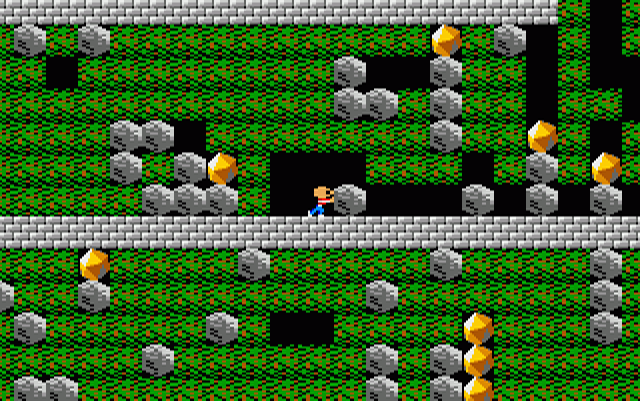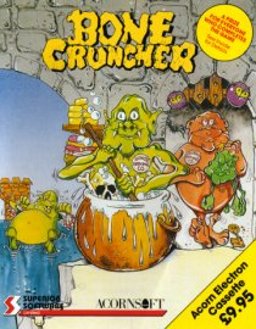Let me explain. This here, in the screenshot below, is a typical Boulderdash screen:
Boulderdash (The Amiga Version) - Prettier than the original 8-bit versions.
Now, there's quite a few things missing on this screen, but three of the absolute basic elements are here: Your hero (named Rockford), who must collect all the diamonds/eggs/whatever the hell thing he's collecting today (Believe me, it varies, but most often it's diamonds, because diamonds were easy to draw on an 8 bit game), while not getting trapped or crushed by rocks (which follow certain rules you can abuse, and later have to abuse), or killed by monsters and fungus. You also have a time limit in each level, which can, in some versions and clones, be reset or added to with a collectible. A nice, simple formula that spawned... Metric fucktons of clones.
But not every game was a lazy clone, and, while all four of the games I'm now going to talk about were moderately popular at the time, they've been relegated to the sidelines of gaming history, for the most part.
First up is Repton Infinity (1988, Superior Software). Repton was the BBC equivalent of Boulderdash, a green lizard man (Rockford's apparently human) who had three main games, a couple of standalone expansions, and Infinity. Infinity was, at its most basic level, a "Make your own Repton", and at first, it doesn't look much more fun to play with, or more powerful, than Boulderdash Construction Kit (released two years earlier than Infinity, in 1986)
But then you actually get into the thing, and you realise (mainly from the demo levels provided) that you can change the rules. Not many of them, but the templates provided allowed for more mechanics than had previously existed across the whole series. Below is one example of the modified rule and tilesets... The worst of the three.
Robbo Doesn't Want to Be Here.
Meet Robbo. Robbo, like Repton, has to collect... Things. But he has different obstacles, and they act somewhat differently to the way they would in the main Repton games: Instead of keys (Which open all diamond-holding safes), he has a computer disk... Which he has to actually put in a computer. There are things he has to hit with a wrench to make them work again. And there are things that don't fall the way you thought they would if you played much Boulderdash or Repton.
The Robbo levels were annoying as hell, but they opened up the game to ever so slightly more than just "I recolour Rockford to be Red, and make maps". I respect that. So, moving on...
Bonecruncher, also from Superior (I'm not promising, but there might be a pattern here), also experimented. It also had resources to collect, and if you could guess from the cover that it involved bones somehow, you'd win yourself an imaginary cookie: Bono, our hero, is the proud owner of a business selling soap to the monsters that surround his island castle. For reasons best left unexplored (IE - Because it's a puzzle game that wasn't actually worried about plot except as a framing device), monster soap is made from very human skeletons strewn around the castle (5 per bar of soap), and winning the level does not, in many cases, require you to grab them all... Just enough to make soap for monsters. Let's take a brief poke at a Bonecruncher screen.
Ahh, the only unhappy folks are Bono and that eggsiwhotsit.
Okay, we've got most of the game's puzzle elements on this screen, good enough (Thanks Wikipedia). Skeletons for soap: Check. Keys for doors: Check. Thing that could be a monster, but is actually your co-worker Fozzy: Check. Eggsiwhotsit that's probably a boulder: Check. But apart from Fozzy, this doesn't seem that different, does it?
Except... That arrow, and the unpictured elements, are what make this one unique. And challenging. See, even though it looks like it's side-view, it's meant to be a top-down look at a floor of Bono's Castle (Just assume I made a St. Bono U2 joke, to save us both some pain), and those eggsiwhotsits (Glooks) don't fall... But they do stampede in the direction of the most recently soaped-up monster. So, let's break down how this is more complex.
- We have to get skeletons. Okay, that's like Boulderdash, think of them as diamonds.
- Glooks, if they roll over us, will kill us, but will also kill anything they trap. Cool.
- Once we have five skeletons, we find a cauldron to make soap. Okay, that's new.
- Once we have a bar of soap, we can hit up a stairway to throw soap to a monster. This changes the Glooks' "fall" direction after a short period of time, allowing us to get to new places, and changing the layout. Ah, that requires a bit of thought...
- We also have two kinds of monsters, like Boulderdash and Repton. Like those games, they're a wall-traveller, and a chaser. Gotcha.
- We won't always have enough skeletons, which is a shitter, but, if we're low on skellies, we can trap chaser type monsters behind Glooks (if they can't move anywhere, they die and turn into a skeleton), or Fozzie can trap them (Don't depend on him though, his AI's a bit erratic)
- Unfortunately, Fozzie can also get killed by being trapped or Glooks.
- If we really want a monster gone, but don't need his sweet, sweet skeleton, there are pits, too. They'll kill anything that walks into them. Including Bono.
- And finally, once we've taken soap to all the moat-monsters, we move on to the next level.
Clogger, again, is a different beast.
I think it's safe to say... MY MIND!
Clogger is a strange one. Again, the "plot" is only a framework, but collecting things (Apples, in this case) is only half the fun! There was, as an aside, a sort of unwritten rule back then that a game had to have a plot. I've already written about how you don't need plot in a game, and that sometimes it's a waste of time here , and early game devs don't get a pass for this, even if the knowledge wasn't easily disseminated.
Anyhoo, what made this game different? Screenshots don't really tell the whole story, but the two main goals are as follows:
- Collect apples and pies.
- Make a pretty picture by pushing the pieces into place with your shovel attachment.
Yes, it says Commodore on it. Multi platform was a thing, even back in the day!
XOR, like the other games in this article, including Repton and Boulderdash, was about finding your way through a maze, collecting all the things, and reaching the exit. But, unlike pretty much every other game in this post, it didn't have a time limit. It didn't need one, because it was a game where failure was really easy. Let's do our best to sum up how it differed from its compatriots. Screenshot, maestro?
Well, that was needlessly abstract!
What's pictured are a few of the main elements: Masks, wot you pick up. Map segments, which show where masks are (but not you, or those wibbly bits), and wibbly forcefields that, depending on the way they point, either block vertical (pointing horizontal) or horizontal (vice versa) movement through them, but get destroyed when you move through them the right way. Also, that shield is us.
Not pictured is the other shield, which is also us (We can switch between them), chickens that always fall down (and can kill you if they fall on you), fish that move sideways (and again, kill you if they hit you from more than one tile away), and these four elements provide the majority of the challenge of XOR. It's all about "How do I get all these masks without dying or getting into a Dead Man Walking scenario?" , and I think the developer was very nice (compared to peers of his time) to not give a time limit for thinking about these things (also a password system and the ability to restart a level. Say "Thank you" !)
If you'd bought the game back in the day, you'd also have been asked by the dev to try and complete the game in a minimum number of moves, for a shiny certificate (Devs liked giving out certificates and letters back then, and I'm sure those who still have their shiny certificates are happy, despite the death-stares child me is throwing them from the ether to this day.) It doesn't look fun, but... Actually, if you like logic puzzles, it straddles that fine line between dickish and engaging with aplomb.
Now, at this point in the post, I imagine some people are expecting some sort of moral, or message beyond "Hey, look at these interesting past experiments in a genre mostly made of the same game, but with different maps for ten years!"
There isn't one. I can't say whether the devs got rewarded for their experimentation, or at least felt they did. I don't think it provides anything clear on the old "Tired Sequel XVIII: The Sequeling versus The New (And Possibly Bad) Hotness" argument (Which is a purely opinion style ballyhoo anyhow.) I don't even think all of them are good (I hate Repton Infinity, for example.) But I do think there's some value in looking at these experiments if you're into game development, seeing how changes to a formula can and can't work in a game. Hell, I think that's a good learning experience overall, for any dev, reviewer, or gamer who wants to know what makes this fucking thing tick. So yeah, they're easily found and played, so give them a shot, see what you think of them, and the changes they made to a formula that, honestly, started boring the tits off me somewhere around 1989.



.png)



No comments:
Post a Comment